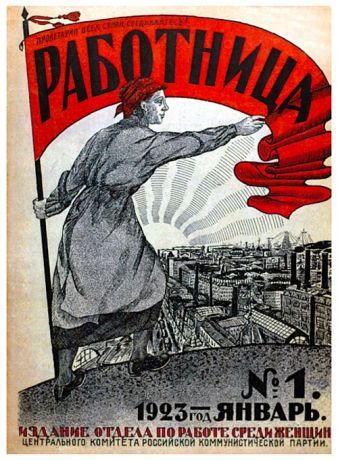Arts
You are here
The story of Comrade Absolute

April 3, 2017
A review of Bolshevik Women, by Barbara Evans Clements, Cambridge University Press, 1997
Barbara Clements has done a real service to the radical left. Her book covers the revolutionary careers of Bolshevichki, women Bolsheviks, from the late 1800’s, through the revolution of 1917, during and after Stalin’s counter-revolution. Her study uses a database of 545 Bolshevichki, women who joined the party before the end of 1921. She also includes details of the lives of seven individuals, Inessa Armand, Evgeniia Bosh, Konkordiia Samoilova, Elena Stasova, Alexandra Kollontai, Rozaliia Zemliachka, Alexandra Artiukhina and Klavdiia Nikolaeva. Some were chosen for their prominence in leadership positions and others are more representative of the rank and file members of the party.
In their early careers the Bolshevichki shared the same duties as the men of the party. They also shared with the men a common appreciation for tverdaia , “an adjective that literally means ‘hard,’ ‘firm,’ and ‘steadfast.’ A tverdaia revolutionary woman was tough, durable, and, if need be, merciless. She was an equal member of an egalitarian movement . . . Her primary loyalties . . . were to her comrades, to the revolutionary movement, and to the cause of social transformation.” Many of the members of the Bolshevik party took on aliases, Stasova choose “Absolute,” and Zemliachka, “Hard as a rock.”
The women in the Bolsheviks were treated as equals, and held positions of authority unimaginable in other political parties around the world at the time. The Bolshevichki were active at all levels of the party, and were arrested as frequently as the men. There is still evidence of some differentiation of roles by gender. Each city committee was lead by three secretaries, an organizing secretary responsible for setting policy, a propaganda secretary for managing publications and propaganda, and a technical secretary for keeping the illegal organization running: connecting with other party organizations, hiding members avoiding arrest, collecting and disbursing money. Clements’ research shows that women in these leadership positions tended to be the technical secretaries. Women were well represented on the regional and city committees but tended to be underrepresented on the higher leadership bodies.
During the months after the overthrow of the Tsar and in the lead up to the October Revolution, women in the party were as likely as men to be elected as delegates to local soviets (workers’ councils), but only half as likely to be elected to the Soviet’s executive committee. While ten per cent of the men in Clement’s database were elected to the Bolshevik Central Committee in this period, only five per cent of the women were.
Which goes to show that even within a party as egalitarian and clear on the need to sweep away all the muck of the ages, as the Bolsheviks were, people are still burdened by the ideas of the society that produces them. Only meticulous attention to issues of oppression can make headway against it. The Bolshevichki led that struggle.
After the successful revolution of October 1917, the women in the party continued work throughout the party and throughout the new workers’ government, including in the military, defending the revolution. They also continued working on the party’s journal for women, Rabotnitsa (Woman Worker), and started a new journal. Rabotnitsa was started in 1914 under the leadership of Samoilova.
In the fall of 1918, Armand, Kollontai, Samoilova and Nikolaeva organized the First All-Russian Congress of Working-Class and Peasant Women. Over one thousand delegates attended. Out of this the Bolsheviks tried to organize committees for work among women in party organizations in all cities. Some committees flourished and others didn’t. As a result, in the fall of 1919, Armand was appointed to head up the Department for Work Among Women, which is more commonly referred to by its acronym, Zhenotdel. Clement reports that, “The Zhenotdel quickly became an all-female world that encouraged emancipatory thinking among young women” Their mission was to build support among women for the revolution.
The Zhenotdel was crucial, the prejudices and habits of centuries can only be eradicated by a determined fight. Central to Marxism is the knowledge that only the oppressed and exploited can liberate themselves. Clements summarizes an article published in a newspaper in Petrograd in 1918, signed by “Anna.’ Anna called for the appointment of women judges. She argued that the revolution had allowed women to become “strong and free citizens, not inferior to men in anything.” Despite working for wages, and achieving equality at work, at home they lived in a “medieval household.” They were prevented from full independence by men who had traditional ideas and treated their wives as property. Women must be able to take their children and leave these slave masters, despite “the people’s court” of public opinion, and women judges would rule fairly in these cases.
The Zhenotdel, the fight for women’s liberation, and so much more was destroyed in the Stalinist counter-revolution. Bolshevik Women chronicles this era as well.
The heroism and commitment of the Bolshevichki is inspiring to read and learn from. The only drawback of this book is that the author doesn’t seem to share the politics of her subjects. But ignore that, and read this book to honour the memory of Comrade Absolute, Comrade Hard as rocks, and the rest of the Bolshevichki. We can learn form their experience then to build the revolutionary organization we need now.
Join the conference One Solution, Revolution: Marxism 2017, April 21-22 in Toronto, including the session "1917-2017: 100 years since the Russian Revolution"
Section:










